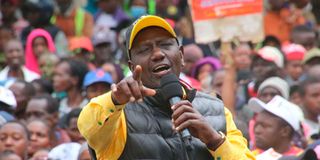Coverage of presidential campaign, opinion polls and tallying of ballots

Deputy President William Ruto addresses wananchi during a Kenya Kwanza campaign rally in Nanyuki town on August 5, 2022.
Research in Western countries show media coverage is one of the most important factors in determining whether a presidential candidate wins or loses an election.
Candidates hire media experts to ensure they receive extensive media coverage. The experts use the media to control the public image of their candidates. It’s assumed that the candidate with the most positive image wins.
Kenya election campaigns have been moving towards this heavy reliance on media coverage including political advertising.
The campaign leading to the August 9 election was characterised by an aggressive media coverage never seen before in Kenya.
It’s intriguing that Raila Odinga who received the lion’s share of the media coverage lost the presidential election to William Ruto.
A survey by the Media Council of Kenya (MCK) shows that Mr Odinga received 61.24 per cent of the media coverage compared to Dr Ruto’s 38.20 per cent.
The study conducted between April 1 and June 6 shows that Raila received two times more television coverage than Ruto.
In particular, in Mt Kenya region Mr Odinga lost to Dr Ruto despite the skewed media coverage in his favour provided by Royal Media Services vernacular TV and Radio (Inooro) and Mediamax Network vernacular TV and Radio (Kameme), owned by S. K. Macharia and the Kenyatta Family respectively.
Although the MCK study was quantitative rather than qualitative, there is anecdotal evidence that the media coverage for Mr Odinga was also more positive than that accorded Dr Ruto.
So, going by the media influence theory, Mr Odinga should have won the election hands down. Did the election results turn the theory on its head?
Media coverage is just one of the factors that influence election outcomes. Other factors must have come into play to defeat the theory. What were those factors? Election researchers should tell us.
* * *
Journalists and readers should interrogate opinion polls. They shouldn’t be taken for granted. This is clearly demonstrated by the fact that all the opinion polls wrongly showed Raila Odinga winning the elections.
Just a few days before election day Tifa, for example, showed Mr Odinga winning with 53 per cent of the votes with William Ruto lagging behind with 45 per cent of the vote.
In its brief guide to the reporting of polls, the British Polling Council advices journalists to critically evaluate opinion polls. They should ask five crucial questions: How and when was the poll conducted? Who was interviewed? How were they chosen? Who sponsored or paid for it? What questions were asked?
Readers should ask the same questions when reading opinion polls. Still, we must conclude that even with those questions satisfactorily answered, polls remain at best mere representations of public sentiment at a particular point in time.
As the University of Minnesota journalism professor, Benjamin Toff, says polls are “more pointillism than photorealism” and should never be mistaken for “the actual thing.”
* * *
IEBC should be congratulated for its bold act of transparency. It uploaded raw vote numbers online for the media and public to do their own math to establish who won the election.
The move, if maintained for future elections, will enable the media to play its vital role in reporting election results and monitoring vote counting.
It’s unfortunate the media failed their audiences by not completing the tallying. Media tallying centres slowed down, then stopped announcing the results while the public anxiously waited.
The least they should have done was to explain why they stopped and apologize to their audiences. They were not transparent and accountable in that regard.
* * *
Where will the pendulum rest? NTV went too far in its creativity trying to report graphically the changing vote tallies. It introduced each report with a full-screen display of the headshots of Raila Odinga and William Ruto, separated by a simple pendulum. For a good 26 seconds the pendulum swung back and forth, revealing one headshot as it obliterated the other. A banner superimposed over the images read: “WHERE WILL THE PENDULUM SETTLE?”
The metaphor was inaccurate and misleading. Votes don’t oscillate or vibrate as pendulums do; they move in a linear motion. And a pendulum rests in the mean position; in this case it would settle between the two headshots and there would be no winner. Besides, it takes forever for the pendulum to settle. The metaphor was way off the mark.
The Public Editor is an independent news ombudsman who handles readers’ complaints on editorial matters including accuracy and journalistic standards. Email: [email protected]. Call or text 0721989264





